Foot fungus or onycomycosis are a common problem that every person risks facing life, regardless of age or social status.This disease is associated with extremely unpleasant symptoms associated with aesthetic changes in nails and physiological discomfort.This is due to the fact that the lower extremities are much more often in contact with the contaminated environment.In this case, the main cause of the occurrence is reduced immunity.The weakened organism is unable to fully resist an infectious agent
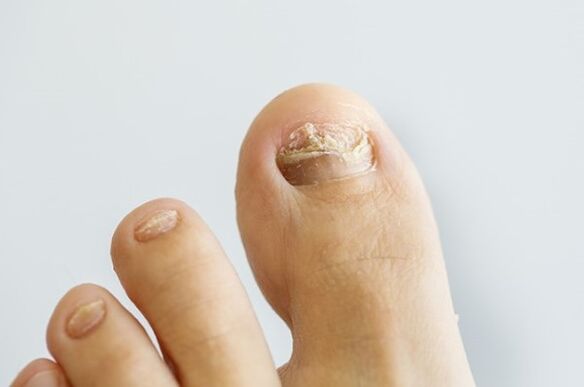
If we speak specifically about fungi on the nails, there are a number of factors that contribute to the infection:
visiting public places without shoes.This is especially true for baths, saunas and pools, showers in the gym or production, hospital departments in a hospital.In the first two cases, the risk of infection is high due to the participation of such places by people who are carriers of fungal infection.In addition, mushrooms are multiplying more in a wet environment.Hospitals, despite compliance with sanitary standards, are a place of concentration of various infections, including those of the fungus.By becoming barefoot on the floor in one of these places, the probability of getting an infection increases ten times
In the absence of regular cleansing using aggressive chemistry, its baths also become a fungal infection shoot.Even if none of the housewives were ill of onycomycosis, pathogenic fungi provided they live on human skin multiply in the unclean bath.An increase in their population leads to deplorable consequences.
- Në mungesë të pastrimit të rregullt duke përdorur kimi agresive, banja e saj bëhet gjithashtu një fidan i infeksionit të kërpudhave. Edhe nëse asnjë nga ato shtëpiake nuk ishte e sëmurë nga onikomikoza, kërpudhat patogjene me kusht që jetojnë në lëkurën e njeriut shumëfishohen në banjën e papastër. Një rritje e popullsisë së tyre çon në pasoja të mjerueshme.
- Wearing old shoes or other people, as pathogenic fungi provided are on the skin, their shoes that enter (especially the closed type) are inevitable.Microorganisms accumulate in layers of tissue, which also increases the risk of infection
- shoe coating is not seasoned - one of the factors of infection is excessive foot sweating.If a person walks with closed shoes during the summer or wears warm shoes in the room, the probability of fungal damage increases
- Hygiene violation - many people do not pay close attention to the hygiene of the lower extremities.However, periodic nail cutting and careless washing of soap legs may not be enough.It is important to cut the nails regularly, cut the burrs and push the cuticles, use special lotions and constantly clean the keratinizing layers of the skin
- Injuries - we are talking about damage to the nail plate with strokes, bruises, cuttings.In such cases, blood circulation is disturbed in the damaged area, the nail does not receive the right amount of nutrients.This can provoke the development of fungi
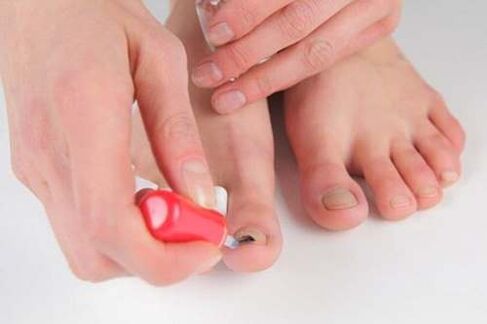
Types of fungi and features of nail damage to the foot
The treatment features depend on the identification of fungal species that affect the nail plate.This is due to the possibility of choosing medicines that indicate activity in relation to a particular type of pathogen and the application of more effective treatment
Dermatophyte
the most common type of pathogen.According to statistics, dermatophytes cause a fungus on the nails of about 75-80% of cases.In this case it is that the condition of the immune system plays a key role in the appearance of onycomycosis.With normal immunity, fungal damage to dermatophytes is almost impossible.
The infection comes from people or animals that are carriers as well as in contact with the land.Ceratinocytes, cellular structures of the epidermis, the high content of which is observed on the nails are a favorite medium of this type of fungus.Gradually moves to the root of the nail plate.In most cases, it is this species that affects the fingers.It is characterized by the simultaneous damage to the nails on some fingers (often standing close).The characteristic signs of the infection are the obesity of the affected area of the nail and its delain.The skin under the outer aspect of the nail plate dries and peel
Trichophyton is among the community - in this case, the onycomycosis of the white surface develops.The favorite species habitat is wet, often found in baths, baths, pools.The causative agent most often touches the last finger of the lower extremities, after which the other nails "catch".A characteristic feature is considered to be focal damage to the nail plate with the appearance of special white stains or strips.In the future, white areas grow, joining together.When the forms of fungal life spread to other fingers, there are areas of dried skin and peel between fingers
- Peak
- Another pathogen of fungal damage on the foot is pathogenic fungi provided by the Candida family.They are considered conventional and pathogenic due to the fact that they constantly live on the surface of the human skin.This means, for infection, contact with an infected person, animal or external environment does not need at all.In this case, the main promotion of pathology is a significant decrease in immunity, immunity
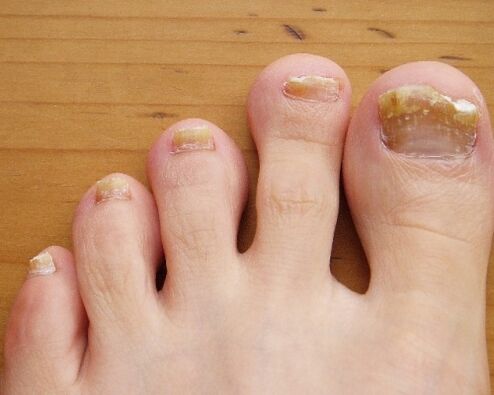
Një patogjen tjetër i dëmtimit të kërpudhave në këmbë në këmbë është kërpudha patogjene me kusht nga familja Candida. Ato konsiderohen konvencionale dhe patogjene për shkak të faktit se ata vazhdimisht jetojnë në sipërfaqen e lëkurës së njeriut. Kjo do të thotë, për infeksion, kontakt me një person të infektuar, kafshë ose mjedis të jashtëm nuk ka nevojë fare. Në këtë rast, nxitja kryesore e patologjisë është një rënie e konsiderueshme e imunitetit, imunitetit.
Unlike dermatophytes, yeast fungi do not form a layer of mycelium, that is, the destruction of the nail plate with this form of damage occurs much less frequently.But the same factor makes the infectious lesion more severe, as the onset of the pathological process takes on the root (proximal) side of the nail.Such varieties of mycosis are considered more severe, but at the same time rare
The first characteristic characteristic of the pathological process caused by the fungus of the top is the detachment of the upper layer of the nail plate.Because of this, the nail loses its brightness, becomes dull and tough.Mushmate nail damage occurs in about 7-10% of cases
Casting
The most secret type of fungus, as these forms of life are almost everywhere (but especially in a wet environment).Damage to the fungus on the nail in the foot can cause about 35-40 subspecies of forms
despite the prevalence in the environment, this form of onycomycosis is rarely diagnosed.In part, as well as because of an atypical clinical appearance, mold is more difficult to diagnose and treat.Another reason for the complexity of the diagnosis of mold onycomycosis is the ability of mold fungi to form mycelium, which makes clinical photography a traction with dermatophyte damage
Fungal life forms mainly affect nails, and species infection is about 10-15%.Nails progress slowly.In the early stages, the fungus can remain unnoticed at all.But there are still symptoms of the early stages of pathology development, which are important to pay attention to:
Shumica e llojeve të dëmtimit të kërpudhave në pllakat e thonjve përparojnë ngadalë. Në fazat fillestare, kërpudhat mund të mbeten fare pa u vënë re. Por ende ka simptoma të fazave të hershme të zhvillimit të patologjisë, të cilat janë të rëndësishme për t'i kushtuar vëmendje:
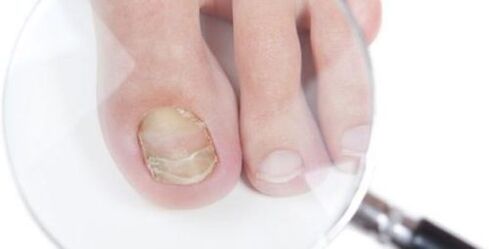
- Growth violation is the first and most vague sign.In a norm state, the nail in the leg grows by no more than 2 mm per week.The nail plate, affected by the fungus, slows the growth rate
- color change - first of all, the nails affected by the fungus fade, losing the shine, becoming matte.It also marks the appearance of white or yellow crossed on the surface of the nail or a complete change in the color of the nail plate (white, yellow or shades of coffee are possible).Changing the color from the nail fungus to the photo above
- Burrs Formation and the damage to the cuticle is another indirect attribute indicating the lesion of the nearby skin fungus.If the burrs began to appear more often, and the cuticular area is inflamed or systematically damaged, it is worth checking a fungal lesion
- Thought or thinning of the nail plate - variations depend on damage to specific fungal types
while the pathological process progresses, the symptoms are becoming more difficult.Clinical signs of later stages of onychomycosis include:
- Changing the surface of the nail plate - becomes rough and uneven, painted with tubercles and waves.Also on the nail, the similarities of crumbs may appear, which indicates a gradual detachment of the upper layer of the nail
- In stages even later, the nail gradually begins to collapse.Initially, this is expressed in laying the nail plate, the appearance of cracks across the surface or chips on the outer edge.This is what this feature of fungi appears on the foot nails in the picture
- In the future, the destruction is even more severe.The nail literally is destroyed, not having time to grow.At the same time, the under -sections which are exposed, and the remaining nail parts look clearly painful and unattractive.As a result, there is a risk of complete destruction or detachment of the nail plate.Heavy lesion with a nail fungus in the photo above
The risk of complications
Many unpleasant sensations and the deterioration of the appearance of nails are just the tip of the iceberg.Lack of timely treatment threatens the development of complications, among which are considered the most common:
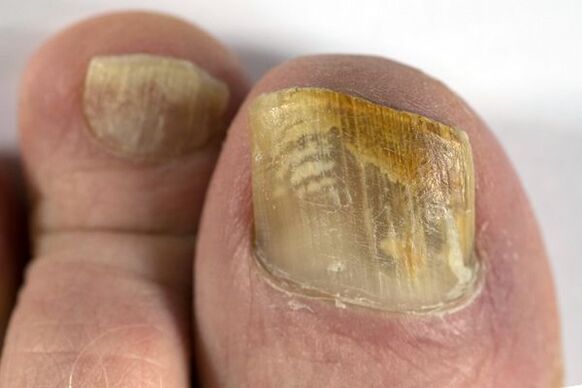
- allergic reactions - at certain stages of development, foot fungi can be perceived by the body as an allergen.other infections in the affected areas.As a result, inflammatory and purulent processes develop
- especially severe cases, undergoing prolonged course and progression of the disease, can lead to the development of fungal mycosis.In this case, the forms of fungal life can penetrate the blood and will be placed throughout the body
- Methods of Treatment
- For the maximum effectiveness of treatment of nail fungus, complex therapy is often used.At the same time, it is previously important to diagnose by planting in a bacterial environment in order to determine the type of pathogen and choose the most effective medication.An integrated approach involves the combination of some types of therapy, but sometimes this is not enough.As part of the treatment, two main groups of medicines are used, depending on the stage of development of the pathological process:
Për efektivitetin maksimal të trajtimit të kërpudhave të thonjve në këmbë, shpesh përdoret terapi komplekse. Në të njëjtën kohë, më parë është e rëndësishme të kryeni diagnostikim duke mbjellë në një mjedis bakterial në mënyrë që të përcaktohet lloji i patogjenit dhe të zgjidhni ilaçet më efektive. Një qasje e integruar përfshin kombinimin e disa llojeve të terapisë, por ndonjëherë kjo nuk është e mjaftueshme.
Barna
Terapia e ilaçeve është baza për trajtimin e shumicës së patologjive, përfshirë lezione të thonjve të kërpudhave. Si pjesë e trajtimit, përdoren dy grupe kryesore të ilaçeve, në varësi të fazës së zhvillimit të procesit patologjik:
- Local type of action - these include ointments, gel, varnish, creams, spraying and lotions with antifungal activity.The method, plurality and duration of the use of such medicines are determined by a physician, but in most cases they are used at least 2-3 weeks
- Systemic antimycotics - are needed for the treatment of nail fungus in the later stages of progress.For the most part, these are tablets, which, after absorbing the gastrointestinal tract, penetrate the blood and inhibit the forms of fungal life, and also do not allow mycosis to spread.The use of systems is important not only to enhance the therapeutic effect, but also in order to prevent relapse
Folk legal remedies
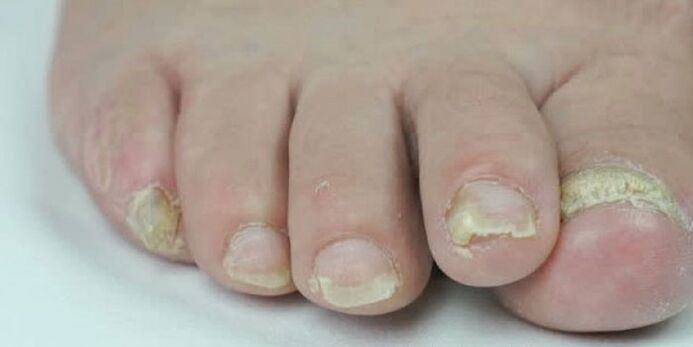
Traditional medicine is considered an auxiliary method to combat fungi in the legs.Popular recipes can improve the antifungal effect.The most effective of them are considered:
- iodine - is able to distribute protein structures, which are the basis of fungal life forms.For treatment daily, apply a few drops of iodine to areas affected with a cotton pad
- Peroxide is an effective antibacterial agent that has a disinfectant effect.To increase the effect, the peroxide is mixed in equal proportions with vinegar.Then the patient is lubricated with a mixture, it is not necessary to rinse it.The procedure is repeated daily for 1-2 weeks
- Celandine - the best method of using this plant for the treatment of fungi on the nails is poultices.To do this, take a tablespoon of crushed raw material (leaves and branches), pour 0.5 liters of water and bring to a boil.The crawling is protected within 15-20 minutes, after which the legs are immersed in it for another 20-25 minutes.Repeat the procedure daily before bedtime for 2-3 weeks
Nail removal
Today in medical practice, the chemical method of removing the nail plate - avulces is mainly used.For this, special aggressive medicines are used, the procedure is performed by a doctor so as not to damage the healthy areas of the nail plate and skin.This method is painless and effective, and indications for its use are the lack of conservative treatment results or advanced onycomycosis cases
Laser
The procedure involves partial or complete removal of the nail plate.The choice of method depends on how deeply the fungus penetrated the nail structure.In the course of laser therapy, an intense method of laser radiation is used.A special apparatus is removed with a layer of nail fungus, after which a course of antifungal therapy is followed

Complete removal of the nail plate with a laser is needed if the nail is completely affected by the fungus, at the base.In this case, after removal, a bandage is applied to the bare areas of the skin, under which an oil or cream with an antifungal effect can be placed.Removing the nail plate requires regular visits to the doctor in order to perform the coating and monitor the growth of the new nail plate
laser treatment of the nail fungus, during which only a few layers of nail are removed, performed in stages, within 7-10 procedures (requires about 10-15 minutes to process).If the removal is indicated, the procedure goes away and lasts about 20 minutes, the patient does not feel pain

















